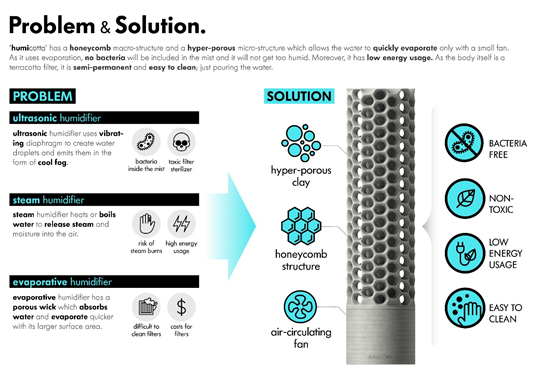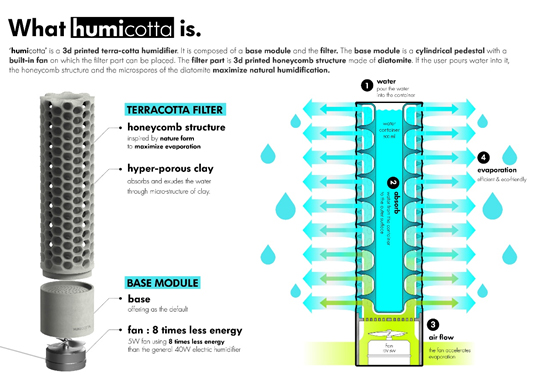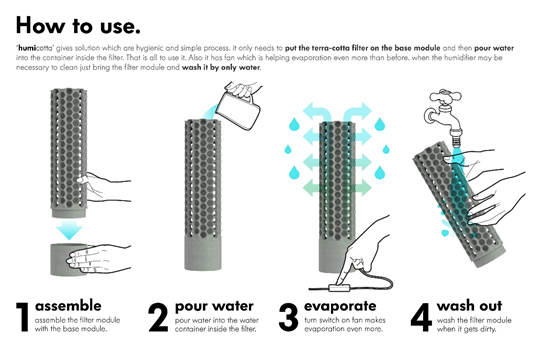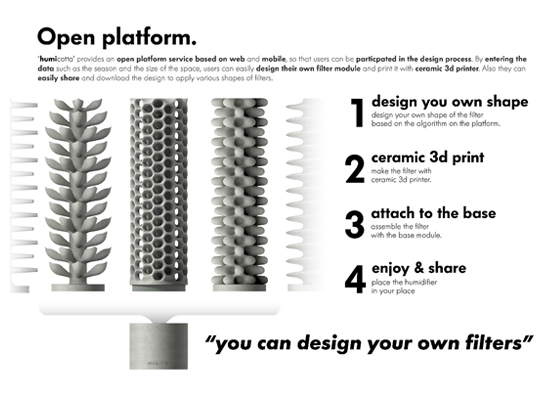KAIST
BREAKTHROUGHS
Research Webzine of the KAIST College of Engineering since 2014
Spring 2025 Vol. 24HUMICOTTA: A 3D-printed ceramic humidifier that is bacteria-free, easy-to-clean, and energy-efficient
HUMICOTTA: A 3D-printed ceramic humidifier that is bacteria-free, easy-to-clean, and energy-efficient
HUMICOTTA is a 3D-printed ceramic humidifier. It is bacteria-free, easy-to-clean, and energy-efficient. It consists of a base module and a filter part. The base is a cylindrical pedestal with a built-in fan on which the filter can be placed. The filter is a 3D-printed honeycomb structure made of diatomite. When water is added, the honeycomb structure and the microspores of the diatomite maximize natural humidification. HUMICOTTA also offers an open platform service that customizes filters or provides files that users can download to print using their own 3D printer.
Article | Fall 2017
It is very important for people’s health to use a humidifier to maintain the proper humidity in the air. However, there are numerous problems with existing humidifiers. Ultrasonic humidifiers are likely to grow bacteria in their water containers. Further, a bactericide can be humidified together in the air. Steam humidifiers have the risk of steam burns, and they consume large amounts of energy.
Existing evaporative humidifiers have complex filters, which have disadvantages in cleaning and maintaining, and these also must be replaced periodically. Thus, a research team called the ID+IM design laboratory (http://idim.kaist.ac.kr/) led by Prof. Sangmin Bae of the Industrial Design Department at KAIST has designed a new type of humidifier called HUMICOTTA.
HUMICOTTA consists of a base module and a filter. The base module is a cylindrical pedestal with a built-in fan on which the filter part can be placed. The filter part is a 3D-printed honeycomb structure made of diatomite. If the user pours water into it, the honeycomb macrostructure and a hyper-porous microstructure maximize natural humidification. As it uses evaporation through the branches of the filter part, no bacteria will escape into the mist and the device will not produce excessive humidity. If a faster humidification is needed, the user can simply press the switch to turn on the fan, which requires eight times less energy than other types of electric humidifier.
Furthermore, HUMICOTTA is easy to maintain. Because the entire filter part is made of diatomite, it can be used semi-permanently, and it is also resistant to contamination. The user can simply wash it in flowing water. Due to its material and structure, it is not apt to break down, and if it does, the user can replace the broken filter parts separately. Furthermore, since diatomite is a type of soil, natural decomposition is possible.
HUMICOTTA also has a distinctive appearance as an aesthetic object. The 3D-printed honeycomb structure of HUMICOTTA is not mass-producible. Moreover, it does not look like a humidifier at a glance because of its unique shape and unusual materials. This will be an attractive factor for users who do not want to ruin the interior of the room by installing a humidifier.
In addition, HUMICOTTA provides an open platform service that customizes filter parts. The size, width, height, and number of holes and branches change depending on the input data from the users, and this service ensures that the appropriated humidity will be provided in the room where the humidifier will be placed. If the user has his/her own 3D ceramic printer, the user can download the printable 3D data file of the filter parts and make it by him/herself.
HUMICOTTA won the Silver prize in the International Design Excellence Awards (IDEA) 2017. The IDEA design award is the world’s most prestigious annual design competition, which is held by the Industrial Designer’s Society of America. This year’s competition drew entries from 54 countries on six continents.
http://www.idsa.org/awards/idea/home-bath/humicotta-3d-printed-terracotta-humidifier
Most Popular

When and why do graph neural networks become powerful?
Read more
Extending the lifespan of next-generation lithium metal batteries with water
Read more
Smart Warnings: LLM-enabled personalized driver assistance
Read more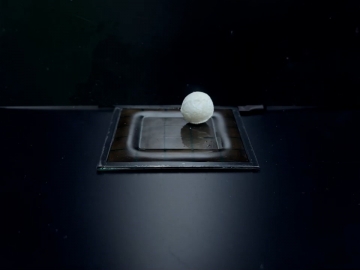
Professor Ki-Uk Kyung’s research team develops soft shape-morphing actuator capable of rapid 3D transformations
Read more
Oxynizer: Non-electric oxygen generator for developing countries
Read more

